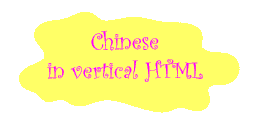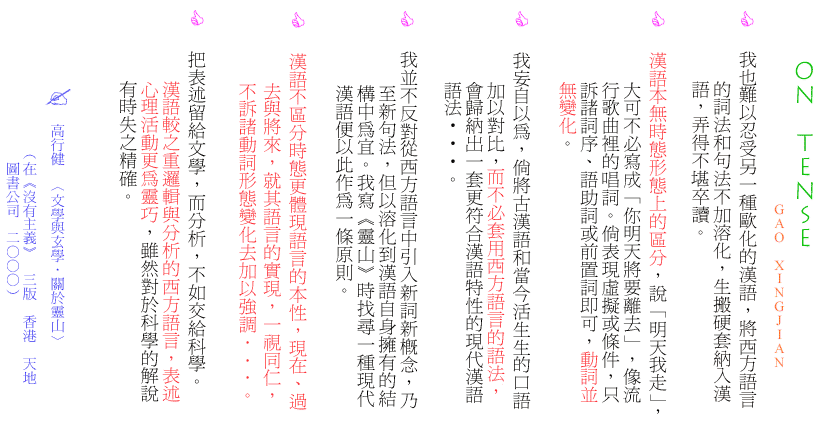CHINESE IN CRISIS
The Nobel literature laureate of 2000,
GAO Xingjian, points to the common error in contemporary Chinese in
the unnecessary use of the tense structure.* This error is basically a result of
the application
of Western linguistic and grammatical theories to the study of the Chinese language which by its nature
requires no explicit tense structure to indicate the temporal dimension of discourse.
In Gao's opinion:
 Having no tense structure, the Chinese language can best handle discourse of
the mind, since in the mind the past, present and future are treated as equal.
Having no tense structure, the Chinese language can best handle discourse of
the mind, since in the mind the past, present and future are treated as equal.
 A grammatical theory for Chinese should be built up, not by modelling on that
of Western languages, but by a contrastive study between contemporary and classical Chinese.
A grammatical theory for Chinese should be built up, not by modelling on that
of Western languages, but by a contrastive study between contemporary and classical Chinese.

The Gardener fully agrees with Gao about the intrusion into the Chinese language by Western grammar.
There are two cases of common yet unnecessary use of tense structure in today's Chinese, based on an
imitation of the tense structure of English:
liao ( ) to indicate past tense of verbs
) to indicate past tense of verbs
jiang ( ) to indicate future tense of verbs
) to indicate future tense of verbs
This usage is no more than "to add legs while drawing a snake".
*See Gao's article "Wen xue yu xuan xue: guan yu Lingshan", in his book Mei you zhu yi, 3rd edition (Hong Kong: Cosmos Book
Company, 2000), pp. 167-182. The following are some relevant passages in the article.
Further Reading (in Chinese)

*
Appeal of the Gardener
Chinese should have no explicit tense structure as in English or other European and East Asian languages.
Chinese should be written vertically, from right to left.
Help preserve our uniqueness, as other peoples preserve theirs.

*

TOP



From CHOR Wing-yip, the Gardener. Canada, May 2001. Revised April 2017.
 Having no tense structure, the Chinese language can best handle discourse of
the mind, since in the mind the past, present and future are treated as equal.
Having no tense structure, the Chinese language can best handle discourse of
the mind, since in the mind the past, present and future are treated as equal.
 A grammatical theory for Chinese should be built up, not by modelling on that
of Western languages, but by a contrastive study between contemporary and classical Chinese.
A grammatical theory for Chinese should be built up, not by modelling on that
of Western languages, but by a contrastive study between contemporary and classical Chinese.

 ) to indicate past tense of verbs
) to indicate past tense of verbs
 ) to indicate future tense of verbs
) to indicate future tense of verbs




